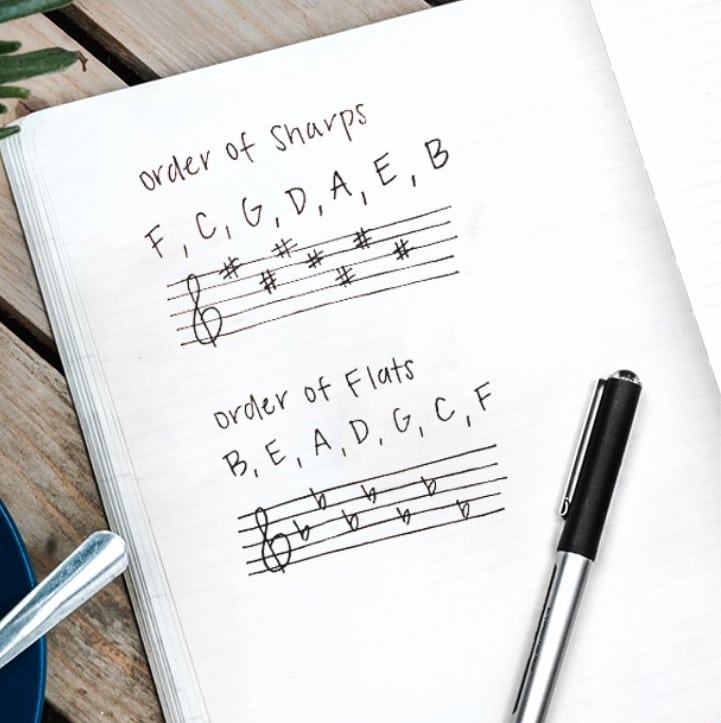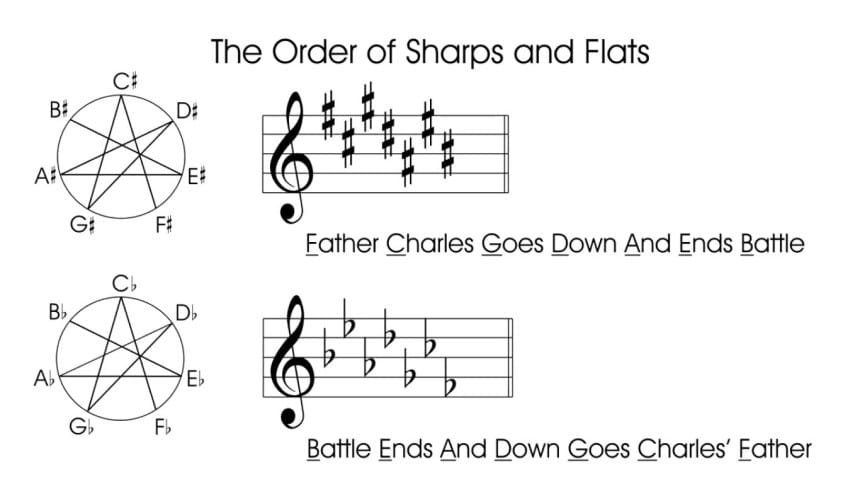
The order of flats is the given position of each flat in a key. As a professional or beginner, anyone who learns music is taught about the Circle of Fifths. This circle is a drawing or representation of all the major and minor keys. Now, each key has a given number of flats and sharps. It is one of the tools for musicians. This order is what we call the order of flats or the order of sharps as the case may be.
As a student of music or a musician, you must learn these. The order of flats or sharps of each key is specific. So, there is a pattern that you must follow. To be able to track the order, you should know it by heart. This way, you will have mastered the flats and sharps in each key, and you will be able to read or play music seamlessly.
One peculiar point to note is that the order of flats reverses the order of sharps and vice versa. This is because it also contains seven sharp notes. They are F, C, G, D, A, E, and B. So the appearance on the key signature is F sharp, C sharp, G sharp, D sharp, A sharp, E sharp, and B sharp. You could learn this order by counting each fifth note in the circle of fifths. It is, however, much easier to use a string of words that you can remember easily, like mnemonics.
Luckily, you don’t have to think up a trick sentence by yourself. Here’s one: Father Charles Goes Down And Ends Battle. This example also happens to be a palindrome, so you can use it in reverse for the order of flats. So the mnemonic for the order of flats would be – Battle Ends And Down Goes Charles’ Father.
Any keys that contain sharps will follow this order of flats. However, in the case of C major, only natural notes are used. It does not include any flat or sharp notes. Other keys contain different numbers of sharp or flat notes. Remembering this order will help you identify all the right notes if they are present.
The order of flats can also be called the sequence or pattern of flats. There are seven flat notes in this order. It goes Bb, Eb, Ab, Db, Gb, Cb, and Fb. Every key that has flats follows this order. They appear in the key signature as B flat, E flat, A flat, D flat, G flat, C flat, and F flat. Once you have the sequence mastered, you will know which flats are present in a key.
For instance, if a key has two flats, it means it contains the first two flats – Bb and Eb. If a key has six flats, the order will be Bb, Eb, Ab, Db, Gb, and Cb. Knowing this, you can determine the precise flats in any given key that contains a flat.
Keys usually have natural notes that may be accompanied by flat notes. For instance, key F has one flat. Since the first flat in the order is Bb, Bb would accompany the other natural notes in the key of F. F major would look like this: F, G, A, (then the first flat note) Bb, C, D, and E.
One easy way to remember this order is to use mnemonics like: Before eating A Doughnut, Get Coffee First. You could also use the reverse of the mnemonic in the example above. This trick would provide further help for playing songs.
A key signature Trusted Source key signature | musical notation | Britannica key signature, in musical notation, the arrangement of sharp or flat signs on particular lines and spaces of a musical staff to indicate that the corresponding notes, in every octave, are to be consistently raised (by sharps) or lowered (by flats) from their natural pitches. www.britannica.com is what brings together the order of flats and sharps on a staff. It is usually beside the treble clef. Without a key signature, there would be confusion as to what a musical staff means. It tells you the position of each flat or sharp.
In addition, key signatures are always in the same sequence. You cannot have a combination of flats and sharps. You would either have flats (according to the order of flats) or sharps (according to the number of sharps).
Now, determining the key signature can be a little tricky, but you will be able to do it easily once you get the hang of it. Remember that key signatures consist of either flats or sharps, and they always follow the order. So, if your key signature consists of sharps, look for the last sharp (to your far right). That previous sharp is the raised seventh. So, the key signature is the note that is a half-step over that sharp.
Let’s assume the last sharp is in the fifth; count using your mnemonic and stop at the fifth word. That would be – Father Charles Goes Down And. That leaves us with an A sharp. Musical notes follow the alphabetical order, so the following letter of the alphabet is B. This means the name of the key is B major.
For key signatures that contain flats, you should look at the second flat (counting from the right). Whatever line that flat is resting on is the name of the key signature. If the signature has only one flat, the key is F (always).
As you may have heard or learned, key signatures are pretty important. Here are some reasons:
Key signatures state whether a natural note is to be raised or lowered. What this means is that the key signature tells you how to play each note. Let’s take F as an example. If your key signature indicates a sharp, it means you should play F as a sharp when you come across it. If the key signature indicates a flat, then you should play the key as a flat.
Understanding key signatures are important for you to read music notes easily. If you don’t understand key signatures, you may not understand the sequence the writer is trying to communicate. For instance, you will not be able to read and play a song even if you have a proper digital piano. So, key signatures are essential for communication and understanding for both students and musicians.
 Remember your
mnemonic
Trusted Source
Mnemonic - Wikipedia
Mnemonics make use of elaborative encoding, retrieval cues, and imagery as specific tools to encode information in a way that allows for efficient storage and retrieval. Mnemonics aid original information in becoming associated with something more accessible or meaningful—which, in turn, provides better retention of the information.
en.wikipedia.org
. If the key signature contains flats, the order is – Battle Ends And Down Goes Charles’ Father. If it has sharps, the sequence is – Father Charles Goes Down And Ends Battle.
Remember your
mnemonic
Trusted Source
Mnemonic - Wikipedia
Mnemonics make use of elaborative encoding, retrieval cues, and imagery as specific tools to encode information in a way that allows for efficient storage and retrieval. Mnemonics aid original information in becoming associated with something more accessible or meaningful—which, in turn, provides better retention of the information.
en.wikipedia.org
. If the key signature contains flats, the order is – Battle Ends And Down Goes Charles’ Father. If it has sharps, the sequence is – Father Charles Goes Down And Ends Battle.The order of flats is not so complex once you learn the basics. What’s more, you can also have fun while learning it. If you are a beginner, it’s okay to learn the principles slowly. What matters is that you master and understand them properly. It will be of great help to you whether you stick to music theory or you decide to play an instrument.
Indeed, after buying a good guitar, like the Fender Squier Dreadnought Acoustic Guitar (which is a full-size guitar constructed with mahogany woods and made to serve both beginners and professionals), then learning how to play it effectively is next. This is also true if you’ve got yourself a digital piano, such as the Donner DEP-20 Beginner Digital Piano (which is a portable electric piano made for optimum convenience.
So, in your practice time, memorize the order. You could use the mnemonics provided or create fun sentences to help you remember. You can test your knowledge with music sheets. Do not be discouraged if you get it wrong a few times. With constant practice and dedication, you will get better and more skilled at your craft.